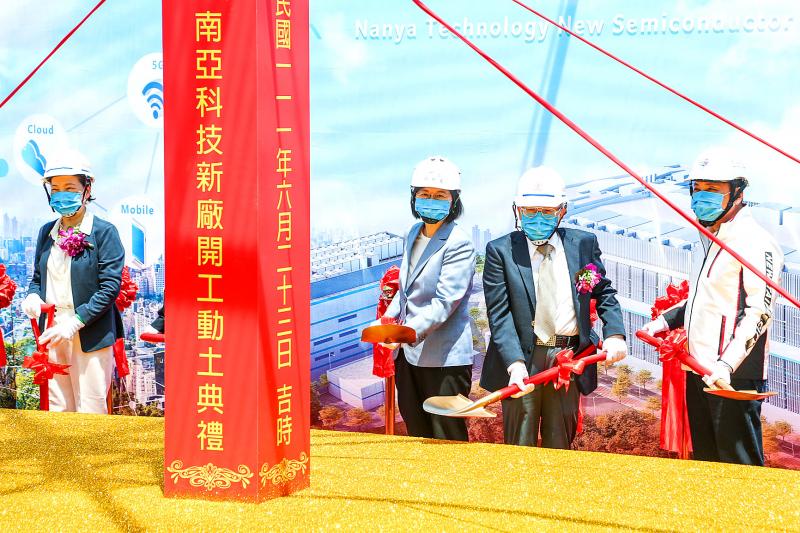DRAM chipmaker Nanya Technology Corp (南亞科技) yesterday said it expects a mild decline in revenue this year as mounting inflation is depressing spending on consumer electronics, which has led to an inventory correction from PC and smartphone companies.
The correction is expected to extend into the next quarter and is likely to last through the fourth quarter, defying the traditional business pattern for the chip industry.
The third quarter is usually a peak season, Nanya said.

Photo: CNA
“There are lots of black swan events this year. Mounting inflation, in particular, has significantly dampened consumer confidence and their purchasing power,” Nanya president Lee Pei-ing (李培瑛) told reporters on the sidelines of a groundbreaking ceremony for the company’s new factory in New Taipei City’s Taishan District (泰山).
“Nanya Technology has done quite a good job in the first half of this year. We hope [revenue] would drop only slightly for the whole year of this year, compared with last year,” Lee said.
Aside from PCs and smartphones, the adverse effect of inflation is likely to spread to server DRAM demand, Lee said.
Server buyers might start to tighten their capital expenditures in the final quarter of the year, he added.
Nanya’s revenue inched up 0.04 percent to NT$32.74 billion (US$1.1 billion) in the first five months of this year, after posting its lowest monthly revenue last month as an uneven supply of key components worsened due to China’s lockdowns.
Despite the slowdown, Nanya does not plan to scale back this year’s planned capital spending of NT$28.4 billion, but some payments might be deferred to next year due to delays in equipment delivery amid a shortage of key components, Lee said.
The chipmaker plans to adjust capacity allocations to cope with the short-term shocks, as it believes the DRAM industry would grow in the long term, given its vital status in the digital transformation, Lee said.
The company serves more than 800 customers with diversified products, he said.
PC DRAM accounts for only about 20 percent of the company’s total revenue, he said.
The company plans to invest NT$300 billion in the new 12-inch fab. That would add 45,000 12-inch wafers to the firm’s monthly capacity of 70,000 wafers, helping it to capture new growth opportunities.
The chipmaker expects the fab to start commercial shipments in 2025 rather than in 2024, with a monthly capacity of 15,000 wafers in the first phase.
The company plans to deploy 10-nanometer process technology, developed entirely by the chipmaker, he said.
It also plans to use extreme ultraviolet lithography, or EUV, tools when the chipmaker starts producing chips using fourth-generation 10-nanometer technology, it said.

GROWING OWINGS: While Luxembourg and China swapped the top three spots, the US continued to be the largest exposure for Taiwan for the 41st consecutive quarter The US remained the largest debtor nation to Taiwan’s banking sector for the 41st consecutive quarter at the end of September, after local banks’ exposure to the US market rose more than 2 percent from three months earlier, the central bank said. Exposure to the US increased to US$198.896 billion, up US$4.026 billion, or 2.07 percent, from US$194.87 billion in the previous quarter, data released by the central bank showed on Friday. Of the increase, about US$1.4 billion came from banks’ investments in securitized products and interbank loans in the US, while another US$2.6 billion stemmed from trust assets, including mutual funds,

Micron Memory Taiwan Co (台灣美光), a subsidiary of US memorychip maker Micron Technology Inc, has been granted a NT$4.7 billion (US$149.5 million) subsidy under the Ministry of Economic Affairs A+ Corporate Innovation and R&D Enhancement program, the ministry said yesterday. The US memorychip maker’s program aims to back the development of high-performance and high-bandwidth memory chips with a total budget of NT$11.75 billion, the ministry said. Aside from the government funding, Micron is to inject the remaining investment of NT$7.06 billion as the company applied to participate the government’s Global Innovation Partnership Program to deepen technology cooperation, a ministry official told the

Taiwan Semiconductor Manufacturing Co (TSMC, 台積電), the world’s leading advanced chipmaker, officially began volume production of its 2-nanometer chips in the fourth quarter of this year, according to a recent update on the company’s Web site. The low-key announcement confirms that TSMC, the go-to chipmaker for artificial intelligence (AI) hardware providers Nvidia Corp and iPhone maker Apple Inc, met its original roadmap for the next-generation technology. Production is currently centered at Fab 22 in Kaohsiung, utilizing the company’s first-generation nanosheet transistor technology. The new architecture achieves “full-node strides in performance and power consumption,” TSMC said. The company described the 2nm process as

Even as the US is embarked on a bitter rivalry with China over the deployment of artificial intelligence (AI), Chinese technology is quietly making inroads into the US market. Despite considerable geopolitical tensions, Chinese open-source AI models are winning over a growing number of programmers and companies in the US. These are different from the closed generative AI models that have become household names — ChatGPT-maker OpenAI or Google’s Gemini — whose inner workings are fiercely protected. In contrast, “open” models offered by many Chinese rivals, from Alibaba (阿里巴巴) to DeepSeek (深度求索), allow programmers to customize parts of the software to suit their